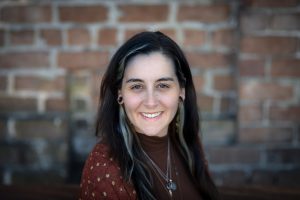Introducing Our New Program Coordinator: Amy Banish
Join us in welcoming our newest program coordinator, Amy Banish.

Amy Banish
Amy Banish joined Georgia Humanities after serving with the National Endowment for the Humanities, where she managed grants that supported public programming, preservation, and education. She earned a BA in English from the University of Alabama, an MA in Literature from Northwestern State University focusing on Southern Appalachian folklore, and an MFA in Poetry from American University, where her collection Mid-Season was published. Amy looks forward to supporting projects that amplify underrepresented voices and expand access for communities whose stories sustain and enculture the humanities.
1. What inspired you to pursue a career in the humanities?
At a very young age I would spend time with a close family friend who worked in the History archives in my hometown of Montgomery, Alabama. He would share the stories of Alabama and Southeastern natives whose accomplishments were cataloged in those archives—gospel singers, quilters, political activists, farmers, and poets. He made their stories come to life, and it was through him that I realized we are the ones responsible for capturing the voices of our communities, memorializing them, and making them accessible to the public so that they may continue to shape us for generations to come. I am so thankful that these early experiences helped pave a very long and winding path to get me here today, helping to continue the preservation of our state’s culture and humanities!
2. Do you have a favorite moment or memory from your previous experience in public humanities that exemplifies why you do this work?
Prior to joining this wonderful team at Georgia Humanities, I helped manage grants at the federal level with the National Endowment for the Humanities. During my time there, we saw many, many fascinating projects and organizations that exemplify the humanities and what it means to do humanities work. I would say that one of my favorite experiences, though, was getting to be a part of the Federal Indian Boarding School Initiative that awarded over $4 million to tribal nations and organizations across the country. Seeing Indigenous communities reclaim and share their stories (on their own terms) was profoundly moving and a humbling reminder that the humanities are not just about studying the past, but about restoring voice and truth to those who have been stripped of that right for centuries—to witness the healing power that storytelling and preservation had on these communities was truly an honor.
3. You’ll be connecting with all kinds of communities through our grant programs, from rural towns to large museums to K12 school systems. What are you most looking forward to about that part of the job?
With two school-aged children of my own, and as a self-declared lifelong student, I am most excited about learning: learning about the communities we are touching and serving, deep-diving into our local and regional histories, and getting the chance to both spread awareness for upcoming funding opportunities and to witness the products of awarded funds in diverse and unique ways. I’m also deeply committed to ensuring that accessibility remains central to our work on every level—both in how we reach and support potential grant applicants, and in how the public experiences and benefits from the projects created by our grantees. My greatest hope is that accessibility opens a pathway for curiosity and learning to flourish, wherever people are.
4. Our state is home to so many great stories. Do you have a favorite Georgia story, song, or tradition that speaks to you?
I am a big fan of folklore—particularly the strange and unusual—and believe state cryptids should be more widely celebrated, so when I discovered that Georgia has their own Loch Ness of sorts, I was thrilled! Claimed to have roots in Muscogee Creek Tribe legends, the lore tells of a long, serpentine creature with a sturgeon-like body, alligator-like snout the size of a “sugar hogshead” (a 60-gallon wooden barrel), and two front flippers that roams the Altamaha River near Darien, Ga. The creature, known as Altamaha-ha (or endearingly known as Altie), was the focus of an impressive hoax done by artist Zardulu in 2018 when he created a stuffed papier-mâché Loch-Ness body and planted it on the shore of Wolf Island, fooling locals and gaining the attention of news stations. Hi-jinx aside, part of the beauty of this lore lies in its connection to Georgia’s history, when early settlers from Scotland’s Loch Ness region navigated into Georgia’s tidal rivers and rice fields along the coast—a reminder that stories are one of humanity’s oldest migrations, carrying history and imagination across oceans, where even the absurd finds a home in the landscape of our collective memory.
5. In addition to our grant programs, you’ll be supporting our new Georgia Circuit speakers’ bureau. What do you hope people take away from participating in a Georgia Humanities program?
It is my hope that people walk away with a renewed sense of connection—both to their neighbors, to their local history, and to the broader communities within the state of Georgia—and I believe that the Georgia Circuit will be a great conduit for that connection. When speakers bring the humanities into local communities, they spark conversations that can help deepen understanding about ourselves and our communities more fully, and they help to empower and inspire us, emboldening a sense of ownership and belonging. It is my hope that all of our Georgia Humanities programs reach audiences near and far to cultivate meaningful dialogue and an exchange of ideas that strengthens civic engagement and helps Georgians recognize the role they play in preserving and honoring our state’s rich cultural heritage.
